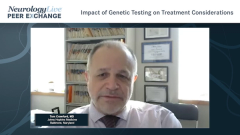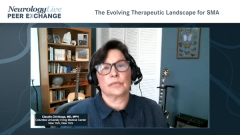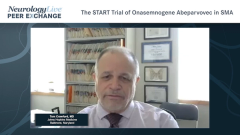
Signs of Symptoms of Spinal Muscular Atrophy
Expert neurologist Carolina Tesi Rocha, MD reviews the signs and symptoms of SMA and their impact on the delay of developmental milestones in infants and toddlers.
Episodes in this series

Crystal Proud, MD: It is unique, Claudia, that your state is including the SMN2 copy number. I know, in my state, we are not including SMN2 copy numbers, and so we are having to gather that after the child has been identified, just based on SMN1 testing. We actually, in Virginia, are not yet up and running with our newborn screening. I hope to be set up later this year. We are still waiting, following, and monitoring patients symptomatically. Carolina, perhaps you could discuss with us some of those symptoms that we might see in our patients who present to us in a state that does not necessarily have newborn screening up and running yet.
Carolina Tesi Rocha, MD: Here, it is important to say that even with newborn screening, there will still be a percentage of patients who will be missed. Even in the cases where we do account for newborn screening and consider that all the patients born after a specific time when that was launched will be diagnosed, we have to remember there will be a percentage who will not be picked up by the newborn screening. As Tom was mentioning, this is a continuum of a disease in which individuals might experience symptoms differently. The disease is divided into these “types” based on the age of onset and functional ability, but there is a range of stability even within each type.
Sometimes, even with all these classifications, there are still about 20% of patients who might not fit into a precise category. That is why it is important to recognize that these patients, again, fall along a continuum of a condition and they are presenting at different ages. For the most common types of this disease in infancy, which now we want to classify as “nonsitters” or “sitters,” and these might still evolve, someone who was a nonsitter, at their next visit could be a sitter. But the patient typically presents with progressive weakness, hypotonia, muscle atrophy, and developmental delay.
The patients’ parents might observe that their child is not reaching typical milestones for their age, such as developing the ability to hold their head up. Younger kids may not be able to roll over or sit up independently. Another reason that it could be noticed by parents or by the pediatrician at the time of evaluation is how the kid is growing and if they have difficulty swallowing. That might become more difficult, and the children might lose the ability to swallow safely; they may be choking and inhaling fluid into their lungs, which ultimately might lead to an operation. Due to this being frequent, many times we make the diagnosis of the patient at the time of the admission because of respiratory complications.
When evaluated, when the patients are finally referred to us, the signs include poor head control, global hypotonia leading to the well-known frog-like posture when lying supine, weak cough, and the weak cry. We sometimes can tell, even when we go into the room, because the pitch of the cry is not typical for a normal newborn or infant because it is weak. We tend to see a progressive weakness of the muscles that are used to chew and swallow, and this will be reflected, as I said before, in a drop in the percentiles that means there is failure to thrive.
The weakness affects both sides of the body symmetrically, with proximal muscles being more affected than the distal ones. The muscles that are affected participate in the patients’ breathing, such as the throat muscles; these particularly will ultimately be affected as well, with the patient showing characteristic paradoxical breathing, leading to respiratory insufficiency and ultimately, chest deformities. There are a lot of descriptions of these classic bell-shaped chests in our patients, particularly those diagnosed with the classic form of SMA [spinal muscular atrophy], otherwise known as SMA type 1, in the past. As a consequence of this progressive weakness and the muscle atrophy, the patient can also start developing spine deformities and contractures of extremities. This also includes the jaw, which could be another limiting factor for feeding later on.
The neurologist or the pediatrician will be able to see, along with the weakness and the low muscle tone, hyperreflexia, and the presence of tongue fasciculations. However, when the patient presents later on in childhood or adolescence, the symptoms that lead to the referral are mostly those related to weight abnormalities, frequent falls, and particularly, tremors that the patients have. The muscles in the leg in those cases tend to be more severely affected compared to the arms, and the patients tend to complain of muscle aches. Fatigue is quite predominant in the population and there are joint symptoms. That is what we tend to see more classically, a different presentation over their lifespan.
Crystal Proud, MD: Thank you for watching this NeurologyLive® Peer Exchange. If you enjoyed the content, please subscribe to our e-newsletters to receive upcoming Peer Exchanges and other great content right in your inbox.
Transcript Edited for Clarity
Newsletter
Keep your finger on the pulse of neurology—subscribe to NeurologyLive for expert interviews, new data, and breakthrough treatment updates.














































